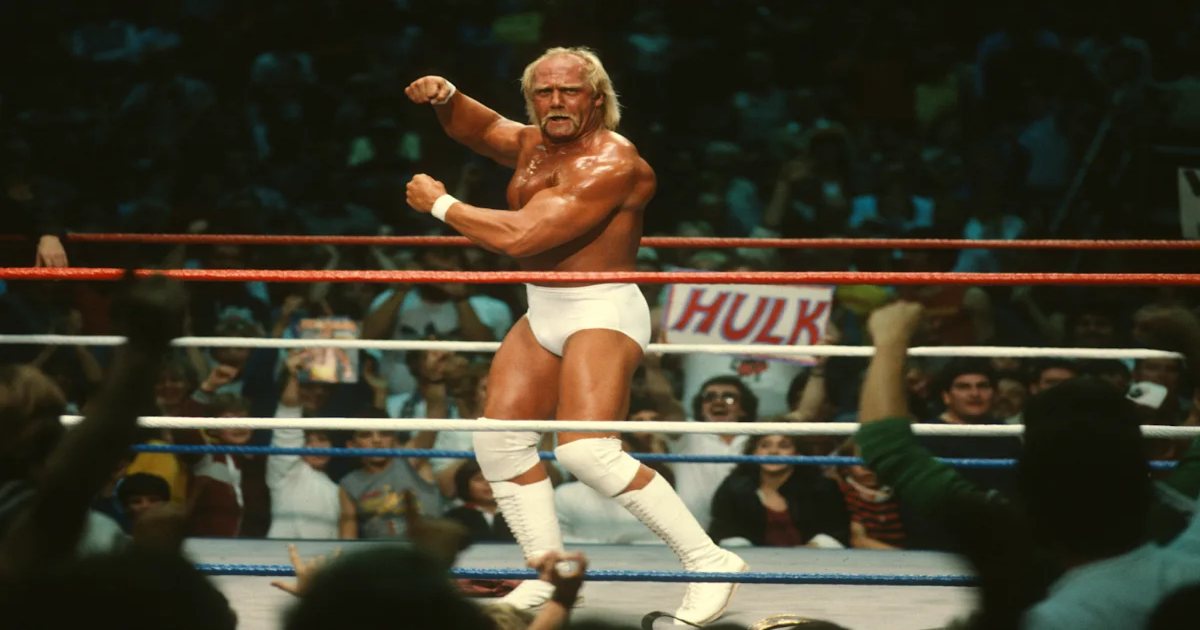Back in pre-internet Britain, light entertainment television shows were a sacred terrain. With just four channels to go around — and one of them reserved for more serious programs — spots on talk shows were generally held for the most universally accessible celebrities: footballers, soap stars and the occasional children’s entertainer.
Given the modest budgets of our television networks, booking an American celebrity was usually a risk in its own right. But to book an American wrestler? That would have been almost entirely unheard of — at least until Hulk Hogan came along.
Advertisement
Advertisement
It’s true that the WWF had some success with its live shows at this point. Just a few months before the Hulkster popped up on “Pebble Lane” — one of the BBC’s particularly twee magazine shows — in 1993 to answer questions about whether wrestling was fake, the company had brought SummerSlam to Wembley. The event had drawn a 70,000-strong crowd, but you wouldn’t know that from watching mainstream British television
In the minds of the BBC commissioners — and a decent chunk of the British public — wrestling was the sort of thing they’d seen on “World of Sport”: the cherished British institution which had turned beefy blokes from provincial towns into matinee idols for a Saturday afternoon audience. It was kitsch, yes, but that was how most of us liked it.
The WWF, by contrast, was brash and bombastic. It was violent and un-PC, and would have likely been instantly pigeonholed by television bosses as the sort of thing that was bound to turn their audiences off and prompt angry letters calling for their sacking. As it turned out, though, all it needed was the right salesman — and that was Hulk Hogan.
In truth, he probably only got booked as he happened to be promoting one of his unsuccessful Hollywood films at the time (the critically panned “Mr. Nanny”). But once Hogan stepped out onto that stage, it didn’t matter. Within a short six-minute segment, British television had found its most interesting character of the week. Soon, he was popping up across the channels, both in Britain and elsewhere in Europe, instantly growing into his role as WWF’s international ambassador.
Hulk Hogan poses in ring during a match while working for the WWE. (Photo by WWE/WWE via Getty Images)
(WWE via Getty Images)
It wouldn’t have been news to Vince McMahon, who knew exactly what he was doing when he sent Hogan on his international media offensive. But from my (admittedly unreliable) perspective as a primary school child in the east of England, it suddenly seemed as if this larger-than-life character was everywhere I looked.
Advertisement
Advertisement
It wasn’t just the talk shows — which, as a kid, I hardly watched anyway — but the lunchboxes, magazine adverts, the GameBoy cartridges, the WWF video cassettes and all of the other paraphernalia that seemed to suddenly be sporting the image of this perma-tanned American hero sent to save us from boredom this summer holiday.
How many other impressionable primary schoolers became wrestling fans due to Hulk Hogan? Of course, it’s impossible to say, but looking back you can clearly see the causation from Hogan being thrust onto our cultural radar and the WWF becoming a mainstream entertainment product in the UK.
Reliable viewings from the time are hard to find. There’s also the fact that WWF’s UK broadcast partner, the newly established subscription service Sky, made some bizarre decision which almost certainly held it back (the historian John Lister charts some of them here). But without Hogan, it’s hard to imagine the WWF building the fanbase it did.
If you speak to wrestling folks, they certainly credit him. Indeed, if you go to certain independent shows over here, you’ll still meet those “World of Sport” veteran types who dislike Hogan for launching what they see as the great Americanization of wrestling. Some resent the fact they had to dress as American characters to get booked in the ludicrous “tribute shows” that were sweeping British towns, with local bruisers pretending to be the Legion of Doom. It’s a unique kind of heel heat that Hogan probably never even knew he ever generated.
Advertisement
Advertisement
Of course, these days WWE’s cultural impact is broadly the same as it is Stateside. But you’ll still spot the occasional testament to Hogan’s enduring cultural legacy — like the fact that so many British men want to dress as him when they go on “stag dos” (our take on bachelor parties) that most party stores will stock a handful of Hogan costumes ready to go. I always smile when I see one of these inebriated Hogans trying to imitate his muscle flex after six pints.
By the same vein, we’re all well aware of the controversies that dogged the man over his career. If he’d have appeared at the last WWE show in London back in March, I don’t doubt the crowd would have booed him just as loudly as they did during the famous Netflix premiere. Maybe even louder, given how we tend to do these things over here.
Advertisement
Advertisement
No matter how hard we would have jeered, though, I don’t doubt there would have been a hell of a lot of fans in that building who would have known — deep down — that he played a big part in them being there in the first place. And, for that, we will always remain grateful.
